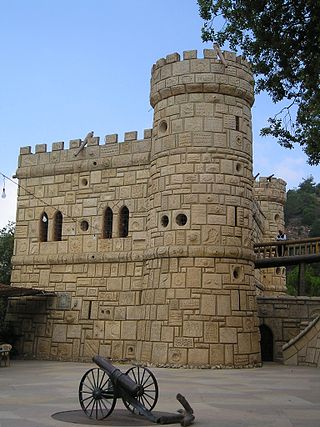
Chouf is a historic region of Lebanon, as well as an administrative district in the governorate (muhafazat) of Mount Lebanon.

Deir al-Qamar is a city south-east of Beirut in south-central Lebanon. It is located five kilometres outside of Beiteddine in the Chouf District of the Mount Lebanon Governorate at 800 m of average altitude.

Beit ed-Dine, also known as Btaddine is a small town and the administrative capital of the Chouf District in the Mount Lebanon Governorate in Lebanon. The town is located 45 kilometers southeast of Beirut, and near the town of Deir el-Qamar from which it is separated by a steep valley. It had 1,613 registered voters in 2010 and its inhabitants are predominantly Christians from the Maronite, Melkite and Greek Orthodox denominations. Beit ed-Dine's total land area consists of 244 hectares and its average elevation is 860 meters above sea level.
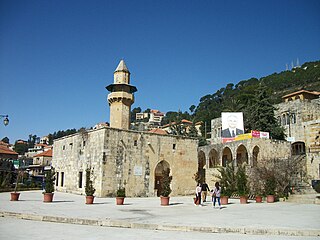
Fakhreddine Mosque with its octagonal minaret is a mosque in Deir al-Qamar, Lebanon. Built in 1493 by Fakhr al-Din I and restored in the sixteenth century, it is the oldest mosque in Mount Lebanon.
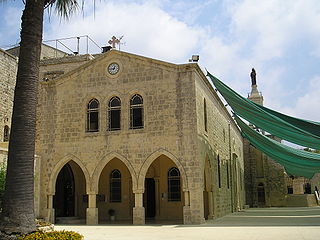
The Church of Saidet et Tallé, sometimes spelled Saydet El Talle and translated as Our Lady of the Hill, is a Maronite church in Deir el Qamar in Lebanon. It is one of the most important historical and religious sites in Deir el Qamar and dates to the 16th century.

Aley is a district (qadaa) in Mount Lebanon, Lebanon, to the south-east of the Lebanon's capital Beirut. The capital is Aley. Aley city was previously known as the "bride of the summers" during the 1960 and 1970s, when Aley and neighboring Bhamdoune were attractive tourist locations for Lebanese emigres and local Lebanese

The Maghen Abraham Synagogue is one of the main synagogues in Lebanon.
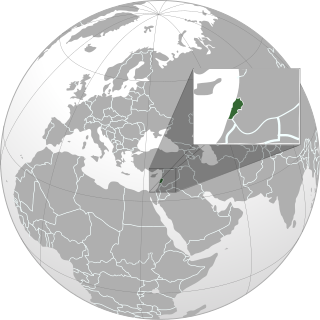
The history of the Jews in Lebanon encompasses the presence of Jews in present-day Lebanon stretching back to biblical times. Following large-scale emigration following the 1948 Arab–Israeli War, and much more importantly the Lebanese Civil War, the vast majority of Lebanese Jews now live in Western countries and many live in Israel. As the latest census in Lebanon was conducted in 1932, there are virtually no statistics available. In 2006, there were about 40 Jews in Lebanon, whereas in 2020 there were only about 29 Jews in Lebanon. Reports indicate that in 2022 the number of Jews in Lebanon was 27 to 20.

Kfarshima, also spelled Kfarchima, is a town in the Baabda District of the Mount Lebanon Governorate, southeast of Beirut and is part of Greater Beirut. The town is populated by Lebanese Christians: mainly Melkite Greek Catholic and Maronites, with smaller communities of Greek Orthodox and Protestant Evangelical Christians. Kfarshima was subject to heavy bombing during the Lebanese civil war since it was a primary fault line.

Wadi Abu Jamil is the former Jewish quarter in Beirut, Lebanon, located in the city's central district.

Historic synagogues include synagogues that date back to ancient times and synagogues that represent the earliest Jewish presence in cities around the world. Some synagogues were destroyed and rebuilt several times on the same site. Others were converted into churches and mosques or used for other purposes.
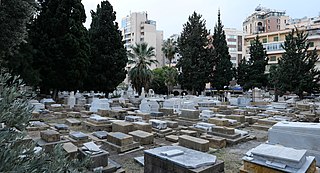
The Beth Elamen Jewish cemetery, is the only Jewish graveyard in Lebanon's capital Beirut.
Dik El Mehdi is a village, at 325 meters elevation, in the Matn District governorate of Mount Lebanon. Its population has been estimated at 2,096 by Aayroun. The village is around 18 km. from Beirut. The majority of it inhabitants derives from the Ashkar family. Many of its inhabitants come from various regions in Lebanon covering diverse political beliefs.

Baakleen, Baaqlîne or Baakline is a major Druze town located in Mount Lebanon, Chouf District, 45 kilometers southeast of Beirut. Altitude 850 – 920 meters high, population is 30,000, area 14 square km, number of homes 2,870. Bordering Towns: Deir El Qamar, Beit Eddine, Aynbal, Deir Dourit, Symkanieh, and Jahlieh.

The Sidon synagogue is one of the oldest synagogues in the world. It is located in the old city of Sidon in the Jewish neighborhood or quarter known colloquially as ḥarat al-yahūd.
The Bhamdoun synagogue is a synagogue built in Bhamdoun in 1922. It is one of the four big synagogues in Lebanon. Its structure still stands despite the building being abandoned.







